Philadelphia / Bucks County LASIK Surgeon – Dr. James S. Lewis
Eye News Volume I Issue 6

HRT II makes diagnosis of glaucoma scientific
Abnomal (glaucoma) eye
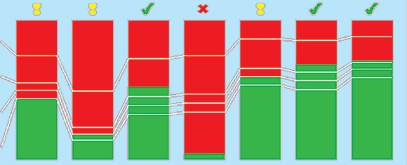
Glaucoma attacks the eight meridians of the optic nerve. The HRT II marks columns as normal with a green check. Borderline areas of the optic nerve have yellow exclamation point. Damaged regions are shown with a red X.
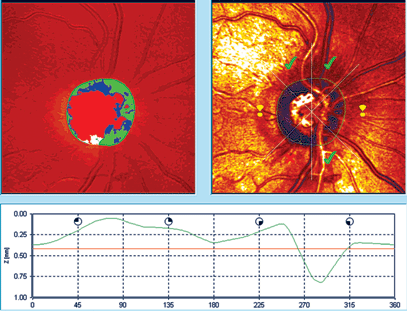
Damage to optic nerve and surrounding nerve fiber layer is shown by these same symbols in the photos above. Injury is suggested when the green line dips below the normal horizontal red threshold.
Normal eye
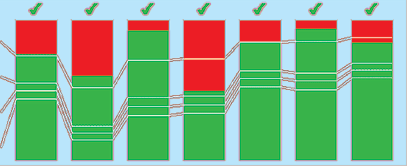
All meridian of this eye are marked as normal. Notice the green healthy neural rim dwarfs the red region of “cupping” in every column. This strongly suggests the absence of glaucoma and other optic nerve diseases.
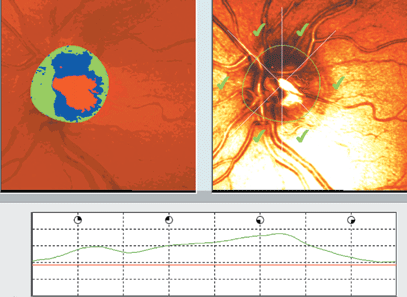
This normal optic nerve has green check marks in all quadrants. Notice the green line never dips below the red line. This study shows a healthy eye. (The position of the red line or threshold is age and sex dependent.)
Statistical analysis fundamental to Heidelberg success
MOORFIELDS, England_ Statisticians at the world famous Moorfields Eye Hospital (http://www.moorfields.org.uk/) have helped eye physicians make sense of this hybrid computer and laser technology. Their work on so-called stereometric parameters allow eye care professions like Dr. Barry Fabriziani to treat local glaucoma patients.
Mrs. Dolores Causland, a longstanding patient of Phoenixville Eye Associates said she has never “understood the diagnosis of glaucoma suspect”. She was delighted by the informative explanation and immediate hassle-free test results.
“This examination is fantastic”, she continued. She was mesmerized by the ‘tremendous” new device.
“Technology has finally caught up,”, exclaimed Joyce Lammey, another longstanding borderline glaucoma patient.
Brenda Dubbs had her medication discontinued after years of use. The HRT II showed no evidence of glaucoma or optic nerve damage. She was ecstatic.
“I don’t know how I practiced quality eye care without the Heidelberg. I can validate my diagnosis with hard data”, said Dr. Barry Fabriziani, OD. “In the fifteen years I’ve been practicing I have never had this level of confidence”.
“Subjecting patients to years of unnecessary glaucoma medications is expensive, inconvenient, and potentially dangerous”, Fabriziani continues. “Patients can find themselves in the emergency room or even the intensive care unit from side effects common to many glaucoma medications.”
“Test results are stored digitally on optical magnetic media with an anticipated shelf-life of over 100 years. I have already filled the first 2.3 gigabyte disc. I am most excited by the ability to follow patients with progressive disease. Adjusting glaucoma medications has now become a scientific practice.”
James Lewis, MD, was invited to Santa Monico, California last week, for the annual Glaucoma Update. Dr. Lewis was one of fifty eye surgeons nationwide sponsored for the trip. He was asked to sign a non-disclosure agreement concerning pharmacologic glaucoma innovations and is required to limit his comments. He could say, “The Heidelberg is playing a prominent role in assessing the value of new glaucoma treatment”.
Dr. Fabriziani feels that “nearly all practioners who plan to manage glaucoma patients in the next decade will need the HRT II”. “It allows me to stop glaucoma therapy when it is unnecessary and start treatment when it is needed. The machine will undoubtedly reduce the cost and inconvience to patients who really don’t need medication.’
Most importantly, Dr. Fabriziani continues, “the HRT II will allow better longterm management of glaucoma patients”. “It should help our universal desire to eliminate glaucoma blindness in this country during our lifetime.”
Mrs. Dolores Causland, a longstanding patient of Phoenixville Eye Associates said she has never “understood the diagnosis of glaucoma suspect”. She was delighted by the informative explanation and immediate hassle-free test results.
“This examination is fantastic”, she continued. She was mesmerized by the ‘tremendous” new device.
“Technology has finally caught up,”, exclaimed Joyce Lammey, another longstanding borderline glaucoma patient.
Brenda Dubbs had her medication discontinued after years of use. The HRT II showed no evidence of glaucoma or optic nerve damage. She was ecstatic.
“I don’t know how I practiced quality eye care without the Heidelberg. I can validate my diagnosis with hard data”, said Dr. Barry Fabriziani, OD. “In the fifteen years I’ve been practicing I have never had this level of confidence”.
“Subjecting patients to years of unnecessary glaucoma medications is expensive, inconvenient, and potentially dangerous”, Fabriziani continues. “Patients can find themselves in the emergency room or even the intensive care unit from side effects common to many glaucoma medications.”
“Test results are stored digitally on optical magnetic media with an anticipated shelf-life of over 100 years. I have already filled the first 2.3 gigabyte disc. I am most excited by the ability to follow patients with progressive disease. Adjusting glaucoma medications has now become a scientific practice.”
James Lewis, MD, was invited to Santa Monico, California last week, for the annual Glaucoma Update. Dr. Lewis was one of fifty eye surgeons nationwide sponsored for the trip. He was asked to sign a non-disclosure agreement concerning pharmacologic glaucoma innovations and is required to limit his comments. He could say, “The Heidelberg is playing a prominent role in assessing the value of new glaucoma treatment”.
Dr. Fabriziani feels that “nearly all practioners who plan to manage glaucoma patients in the next decade will need the HRT II”. “It allows me to stop glaucoma therapy when it is unnecessary and start treatment when it is needed. The machine will undoubtedly reduce the cost and inconvience to patients who really don’t need medication.’
Most importantly, Dr. Fabriziani continues, “the HRT II will allow better longterm management of glaucoma patients”. “It should help our universal desire to eliminate glaucoma blindness in this country during our lifetime.”
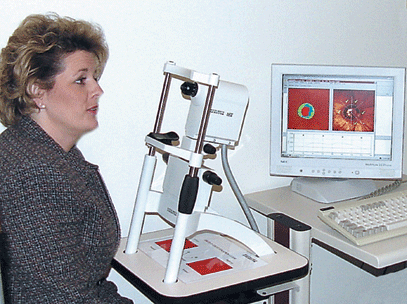
Connie Corbin, practice administrator of Phoenixville Eye Associates verifies her retina and optic nerve are normal.
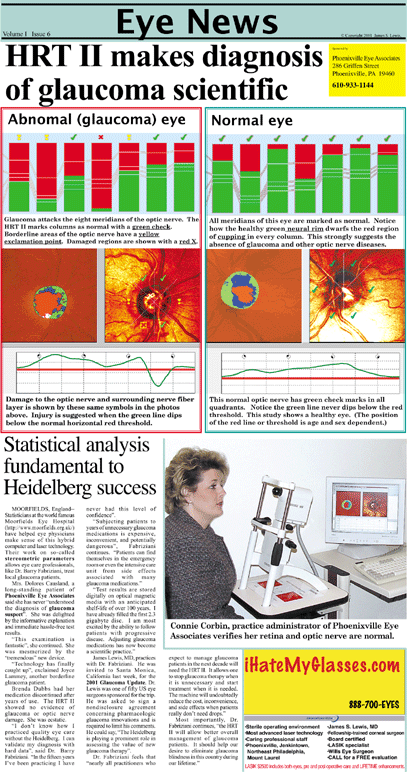
Dr. Lewis is renowned throughout the greater Philadelphia area as a highly skilled LASIK and Epi-LASIK Bucks County, Elkins Park and Phoenixville expert. At his elegantly appointed LASIK Philadelphia offices, patients can also undergo implantation of advanced ICLs, such as Visian ICL.